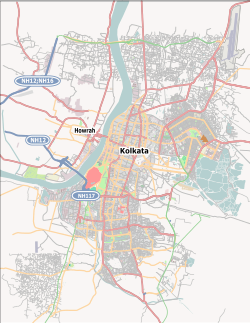Tangra, Kolkata
This article needs additional citations for verification. (January 2017) |
Tangra | |
|---|---|
Neighbourhood in Kolkata (Calcutta) | |
 Gobinda Chandra Khatik Road, Tangra | |
| Coordinates: 22°33′45″N 88°23′11″E / 22.562434°N 88.386435°E | |
| Country | |
| State | West Bengal |
| City | Kolkata |
| District | Kolkata[1][2][3] |
| Metro Station | Sealdah, Beleghata(under construction) and Barun Sengupta(under construction) |
| Municipal Corporation | Kolkata Municipal Corporation |
| KMC wards | 56, 57, 58, 59, 66 |
| Elevation | 36 ft (11 m) |
| Population | |
• Total | For population see linked KMC ward pages |
| Time zone | UTC+5:30 (IST) |
| PIN | 700015, 700046, 700105 |
| Area code | +91 33 |
| Lok Sabha constituency | Kolkata Uttar and Kolkata Dakshin |
| Vidhan Sabha constituency | Beleghata, Entally and Kasba |
Tangra is a region in East Kolkata that traditionally housed many tanneries owned by people of Hakka Chinese origin.
History
[edit]The East India Company obtained from the Mughal emperor Farrukhsiyar, in 1717, the right to rent from 38 villages surrounding their settlement. Of these 5 lay across the Hooghly in what is now Howrah district. The remaining 33 villages were on the Calcutta side. After the fall of Siraj-ud-daulah, the last independent Nawab of Bengal, it purchased these villages in 1758 from Mir Jafar and reorganised them. These villages were known en-bloc as Dihi Panchannagram and Tangra was one of them. It was considered to be a suburb beyond the limits of the Maratha Ditch.[4][5][6]
In the eastern fringes of Kolkata, the neighbourhoods such as Tangra, Tiljala, Topsia and Dhapa, were populated largely with people who migrated from poverty-ridden and caste-ridden villages, in Bihar and Uttar Pradesh. They came with dreams of a better life but landed in the slums with open drains, pigsties, factory chimneys and pungent chemicals. They found work in the tanneries and factories, and also engaged in menial work. A big proportion of them were Chamars, but there also were Doms, Dosads, Mehtars and Kahars. They were all Harijans and they formed a majority. They escaped from persecution they faced in their villages but were far removed from the mainstream of urban life and culture.[7] The Cha Project, is designed to preserve Tiretti Bazaar and develop Tangra.[8]
Geography
[edit]Police district
[edit]Tangra police station is in the Eastern Suburban division of Kolkata Police. It is located at 15, Gobinda Chandra Khatik Road, Kolkata-700015.[9]
Ultadanga Women police station covers all police districts under the jurisdiction of the Eastern Suburban division i.e. Beliaghata, Entally, Manicktolla, Narkeldanga, Ultadanga, Tangra and Phoolbagan.[9]
Transport
[edit]Bus
[edit]Private Bus
[edit]- 24 Topsia - Bandhaghat
- 24A Topsia - Bandhaghat
- 213 Ghatakpukur - Babughat
- SD24 Sonakhali, Basanti - Alipore Zoo
Mini Bus
[edit]- S166 Tangra - Howrah Station
Train
[edit]Park Circus railway station on Sealdah South lines is the nearest railway station.
Education
[edit]Metro Rail
[edit]Barun Sengupta metro station (also known as Science City), is an under construction station of the Kolkata Metro Line 6 located at Parama Island on the EM Bypass is the nearest metro station.
See also
[edit]- Chinese influences on Bengali cuisine
- Hakka Chinese
- Hakka cuisine
- Hakka people
- Indian Chinese cuisine
- Tiretta Bazaar
References
[edit]- ^ "Kolkata South district".
- ^ "South 24 Parganas district".
- ^ "Electors Details As On 30-10-2010" (PDF). Archived from the original (PDF) on 29 May 2013.
- ^ "District Census Handbook Kolkata, Census of India 2011, Series 20, Part XII A" (PDF). Pages 6-10: The History. Directorate of Census Operations, West Bengal. Retrieved 20 February 2018.
- ^ Cotton, H.E.A., Calcutta Old and New, first published 1909/reprint 1980, pages 103-4 and 221, General Printers and Publishers Pvt. Ltd.
- ^ Nair, P.Thankappan, The Growth and Development of Old Calcutta, in Calcutta, the Living City, Vol. I, pp. 14-15, Edited by Sukanta Chaudhuri, Oxford University Press, 1995 edition.
- ^ Bandyopadhyay, Raghab, "The Inheritors: Slum and Pavement Life in Calcutta", in Calcutta, The Living City Vol II, Edited by Sukanta Chaudhuri, Pages 78-82, First published 1990, 2005 edition, Oxford University Press, ISBN 0-19-563697-X
- ^ "The Cha Project will preserve Kolkata's rich history, not glassed up in a museum but as a tangible, living heritage". The Cha Project. Retrieved 31 January 2016.
- ^ a b "Kolkata Police". Eastern Suburban Division. KP. Retrieved 5 March 2018.
External links
[edit] Kolkata/East travel guide from Wikivoyage
Kolkata/East travel guide from Wikivoyage


